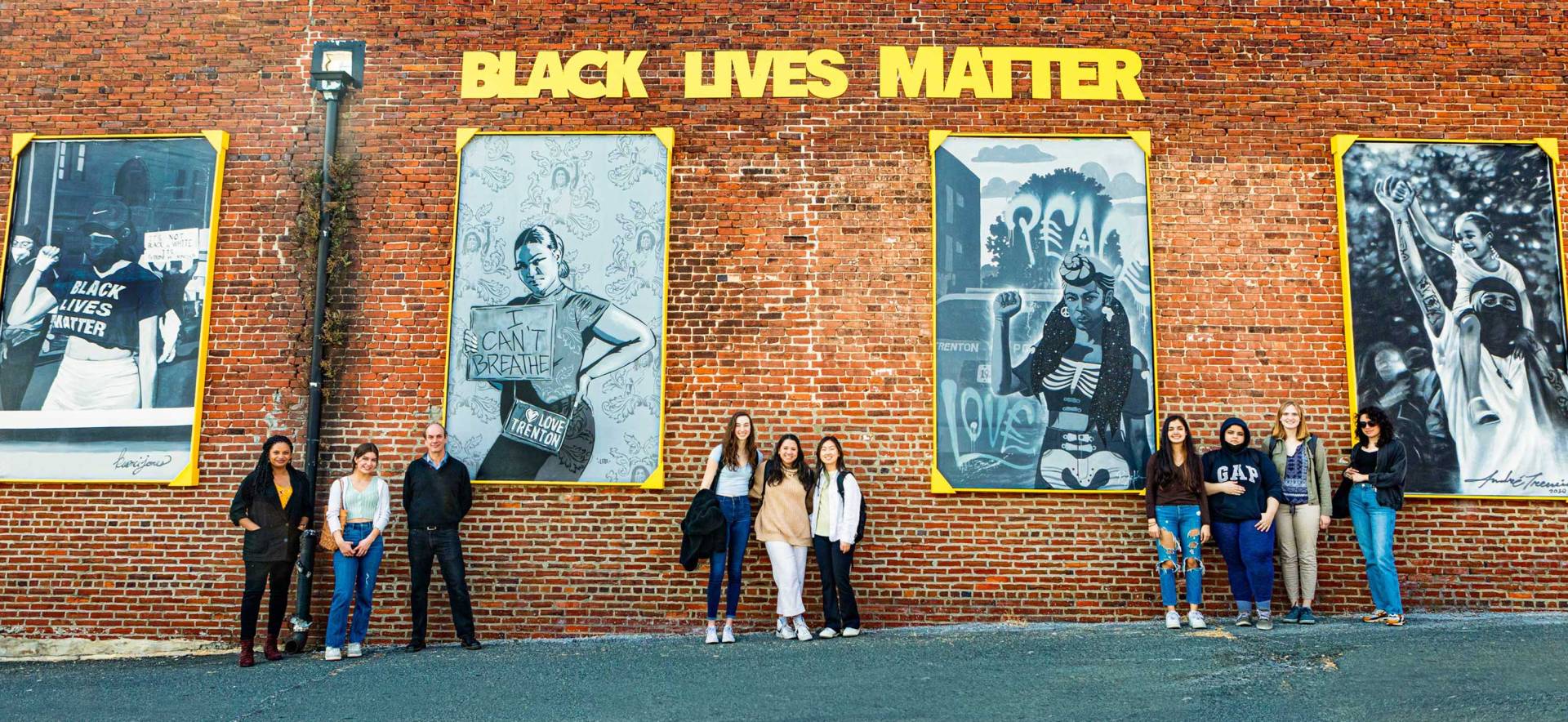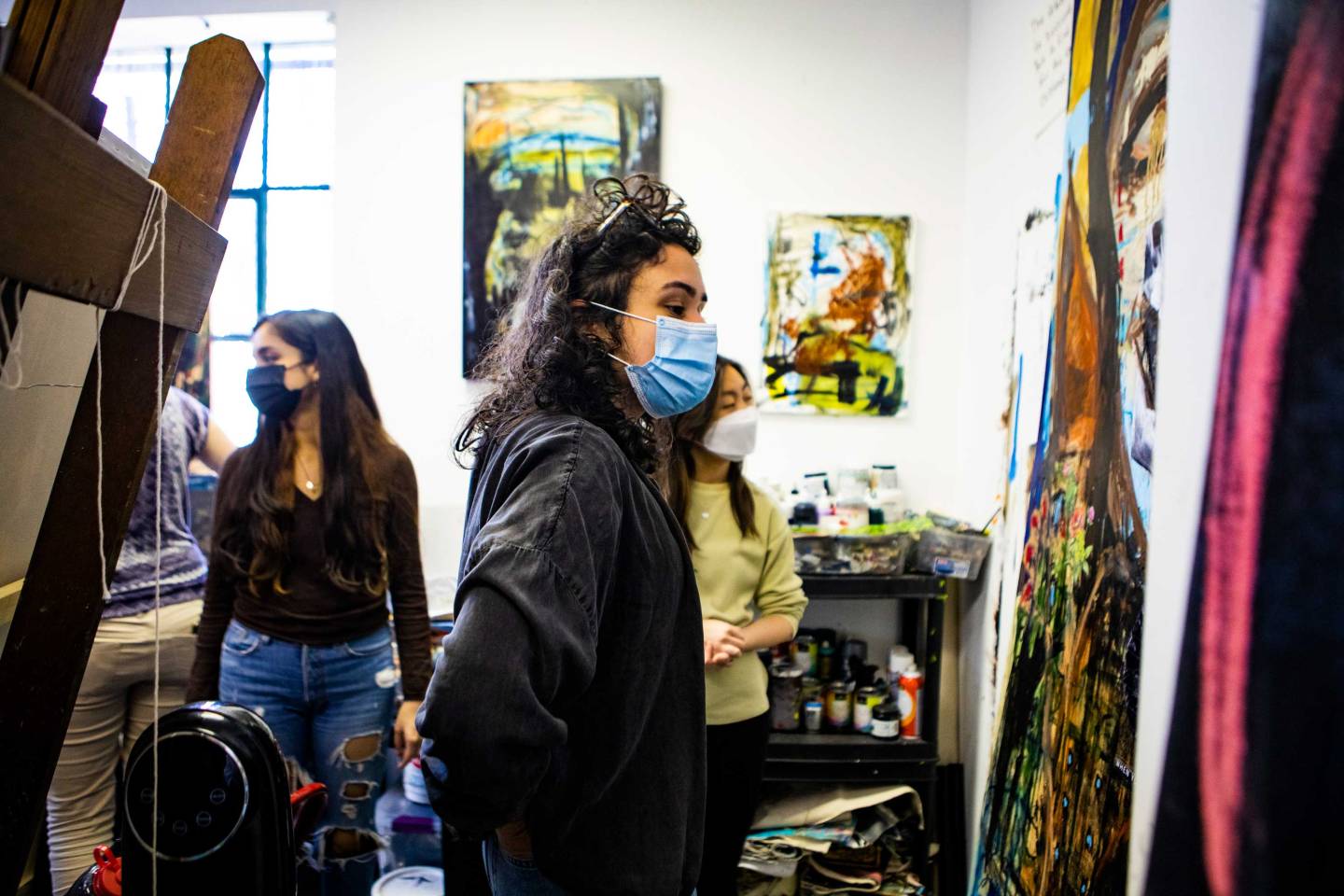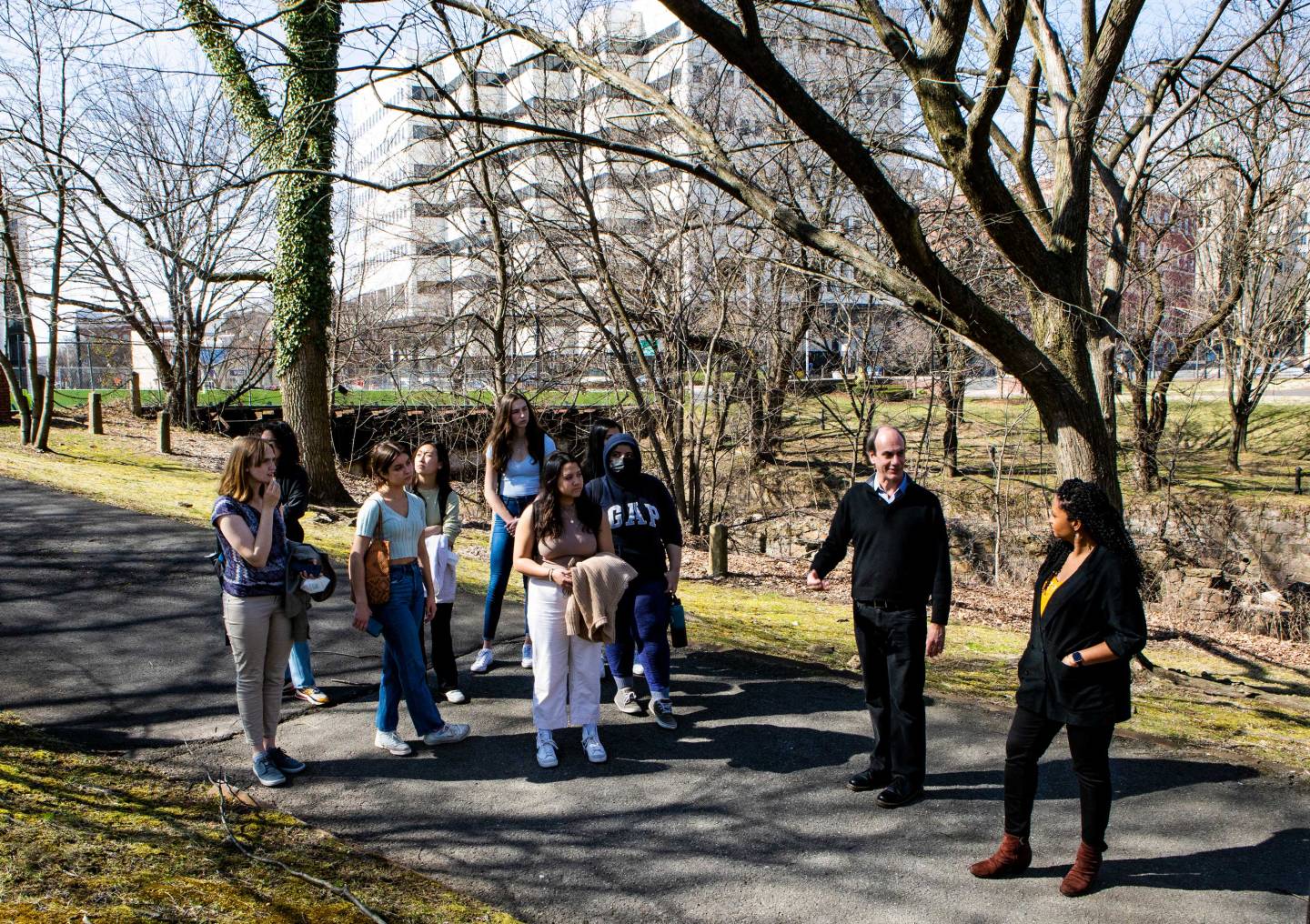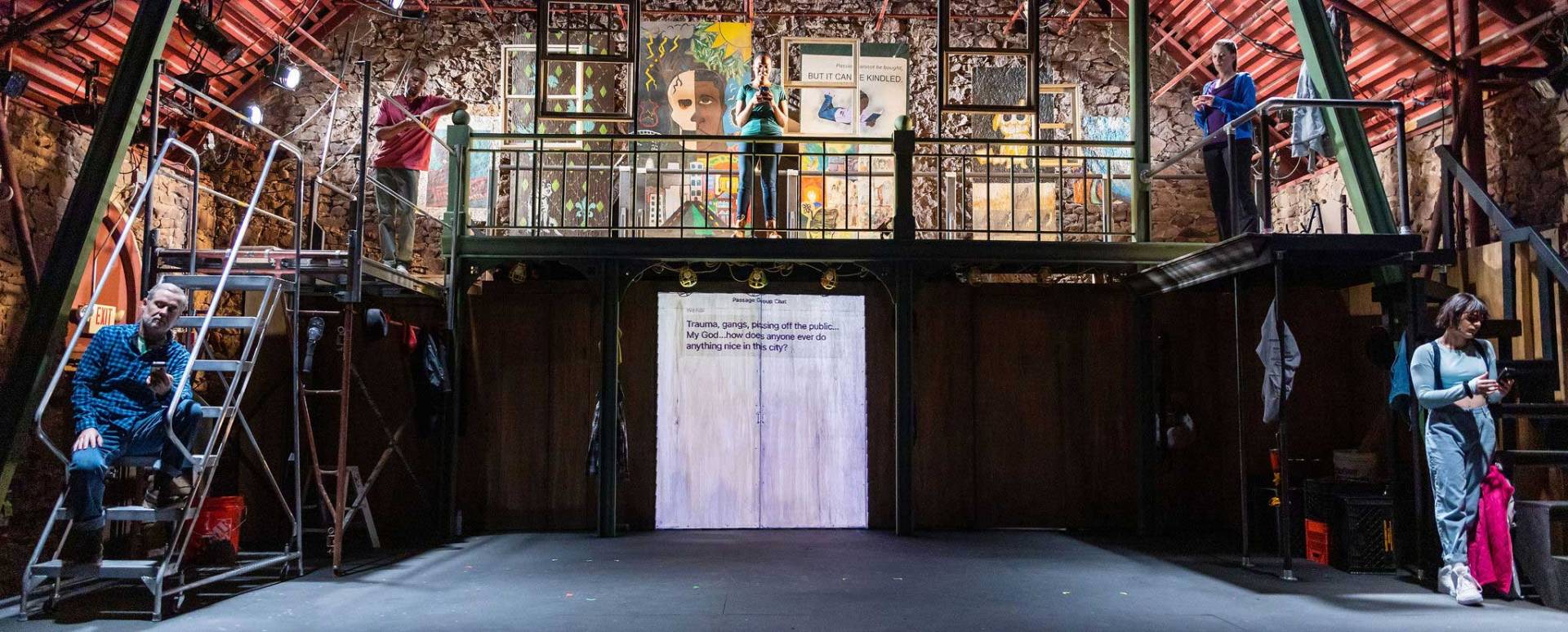What does activism look like in a theater production, in a painting, or on a graffiti mural?
What does close listening mean? And can it, too, be a form of activism?
This spring, nine Princeton undergraduate students set out to answer those questions and others in a course that explored the vibrant arts scene in Trenton, New Jersey, through the lens of activism.
Students in “Arts in the Invisible City: Race, Policy, Performance” had the opportunity to see a performance of a documentary theater work, “The OK Trenton Project,” at Passage Theatre Company. They visited the studio of Tamara Torres, an Afro-Latina artist whose work addresses women's rights and racial equity. They took a walking tour of Trenton murals with graffiti artist Leon Rainbow.
Students examined the historical and contemporary racism that has shaped Trenton — the so-called “invisible” city between New York and Philadelphia — in direct conversation with Trenton’s activists, policy makers, politicians and artists. For their final project, students conducted oral history interviews with a range of Trenton artists.
This team-taught course was led by D. Vance Smith, professor of English, and Nyssa Chow, an oral historian and lecturer in theater in the Lewis Center for the Arts and the Humanities Council. It was supported by the David A. Gardner ’69 Magic Project in the Humanities Council. Cross-listed in English, humanistic studies, theater and urban studies, the course is also part of the Program for Community-Engaged Scholarship (ProCES).
Reflecting the course’s focus on oral history, six participants — professors, staff and students — shared their experiences of teaching, inspiration and discovery:
D. Vance Smith, professor of English, on the transformative power of listening
Smith is a medievalist who grew up in Africa. He moved to the historic Mill Hill neighborhood of Trenton in 2017, quickly became involved in the arts community and joined the boards of Passage Theatre Company and the Artworks visual arts center. The relationships he has built have allowed him to introduce his students to a diverse array of Trenton art makers. This is the second time he has taught “Arts in the Invisible City” and he hopes to continue to offer it.
I think of this course as an opportunity to practice activism as a kind of close listening with humility. I’m challenging my students to think about the vast differences in economics and access to services between Princeton and Trenton. What I hope they take away from this course is the idea that people outside the academy, outside institutions like Princeton, have a lot to offer. It simply is a matter of respecting that, of learning to value what they say.
One moment that leaps out is the walking tour led by Leon Rainbow. He took us past a parking garage with portraits of Trenton artists who have died in last few years. (A different mural, on the side of the Artworks building, is shown below.) The portraits are celebratory and happy. One of the portraits, two stories high, was done by Leon, who is half Native American, as a tribute to his father. Leon told the students, “This is a wall of memorials to people that were close to us." That led to a discussion about how important art like that is for creating and maintaining relationships, and about how it’s a community practice as much as anything else. It was a powerful discovery.
Nyssa is one of the best listeners I’ve ever encountered, and I come from a family of anthropologists. She recognizes the smallest details in a conversation and she’s teaching the students how to practice that.

On one of several trips to Trenton, the students visited Artworks, a visual arts center with professional artists' studios, galleries and workshop space.
Nyssa Chow, lecturer, on listening with intention
Chow is an oral historian, multidisciplinary artist and writer. She was a 2019-21 Princeton Arts Fellow. Inspired by teaching this course, she is creating an audiovisual documentary/composition that will take place in abandoned buildings in Trenton as an invitation for Trenton residents to “co-author” those spaces and imagine an “otherwise” for these buildings.
A common assumption is that oral history is about recording a person’s story. A story is not an artifact that we can extract whole and fixed from within a life. Story is a tool we offer others to translate to us the absolutely particular way they understand and see the world.
Our goal was to invite Trenton artists and residents to be the interpreters of their own lived experiences. It’s about becoming intentional listeners.
We know from everyday experience that the story we’re willing to tell a stranger is different than the story we might tell our best friend — and different from the story we might tell our parents. The students learned that every narrative within the encounter of oral history will be the version we had permission to hear.
Teaching with Vance was a wonderful experience. I deeply admire his long and sincere commitment to Trenton and to the arts. With this class, there is real potential to invest in developing a meaningful and accountable relationship between Princeton and Trenton.
Annie Phun, student, on why it matters who tells a story
Phun, a member of the Class of 2023, is a first-generation college student and a classics concentrator. For her final project, she interviewed Qaysean, a Black, LGBTQIA+ fashion designer who lost the use of his left arm due to a nerve injury at birth.
I’ve been interested in Trenton as a city since I came to Princeton. During first-year orientation, I joined the Trenton Circus Squad as part of Community Action. [But] after that, whenever Trenton was brought up, the negativity of my peers irked me: I’d hear things like “Oh, don’t go there alone” or “That city’s really dirty and full of crime.”

Students wander among Tamara Torres' paintings. "I was inspired by how welcoming [Tamara] was to a group of kids from Princeton, strangers to her and to the town," said Francesca Pauca, a member of the Class of 2024. "I told her that I would like to see Princeton get involved in Trenton in a more collaborative and casual way, so that Princeton students could see Trenton as more than just a place to volunteer."
I wanted to see if there was anything I was missing or anything I could do to help. A lot of the things people say about Trenton resonate with me because the same things are said about my hometown — El Monte, California — which is impoverished and the demographics mainly consist of racial and ethnic minorities.
The “OK Trenton” production showed me how much events or histories get skewed depending on who one is hearing the story from. I enjoyed the way the play represented every perspective without swaying the audience to any specific opinion. It was up to me to decide whether taking down a sculpture was an ethical thing for the city to do, and to reflect on the repercussions of the act.
Francesca Pauca, student, on the power of casual collaboration
Pauca, a member of the Class of 2024, is a psychology concentrator on the pre-med track. For her final project, she interviewed Sam Kanig, a filmmaker and organizer of Puerto Rican/Latinx arts and community initiatives in Trenton.
I grew up in Winston-Salem, North Carolina, but Peru is another home for me. My father is Peruvian and I've visited my family there. Professor Smith pointed out the three Peruvian restaurants in Trenton on our bus tour of the city. I hope that I can continue to connect with this part of me, learning and growing from the surrounding culture.
I felt that having a connection to a city as special as Trenton would remind me of high school memories of trying to find my role in my own community. I hoped that this class would provide me with inspiration, passion and direction for a future in public health, and it has.
In Tamara’s studio, I was inspired by how welcoming she was to a group of kids from Princeton, strangers to her and to the town. I told her that I would like to see Princeton get involved in Trenton in a more collaborative and casual way, so that Princeton students could see Trenton as more than just a place to volunteer.

On one visit to Trenton, Smith led his students on a walking tour, including the park alongside the Assunpink Creek, near the historic Mill Hill neighborhood where he lives. Smith moved to Trenton in 2017 and quickly became involved in the arts community, including joining the boards of Passage Theatre and Artworks.
Dylan Erdelyi, theatre education projects coordinator, ProCES, on the value of multiple perspectives
Erdelyi, a 2021 Rider University graduate, is on a two-year AmeriCorps fellowship, working jointly with ProCES and Passage Theatre to build relationships between Princeton courses and the rich arts resources that Trenton has to offer.
This class is a shining example of community-engaged scholarship in action. We believe it is extremely important to really get to know the community you’re learning about and engage with them as treasured partners.
“The OK Trenton Project” was inspired by real events that took place in Trenton in 2017. A group of students at a summer camp made a sculpture [in the shape of the “OK” hand signal] and it was immediately taken down for its perceived likeness to a gang sign. A team helmed by Passage Theatre’s artistic director Ryanne Domingues — who has trained in developing verbatim theater pieces around community issues — collaborated with students in Vance’s course last year to interview over 35 community members about the events that inspired this documentary theater piece; many appear as characters in the show.
Passage leadership believes it is important to engage all facets of the community when we produce a piece of theater. Princeton students can offer a deep dive into the history and context of the work that is being produced, community partners are able to offer firsthand experience and expertise, and actors and directors bring their training and curatorial knowledge of the craft. The most impactful art is created when all these perspectives work together.
I am excited to see students in this course fall in love with Trenton and the meaningful art that is taking place in this community. Many students, especially those from out of state, aren’t familiar with the richness that the larger New Jersey community has to offer — and it has been uplifting to open those doors for students and community partners alike.

Students had the opportunity to see a performance of the documentary theater work, “The OK Trenton Project,” at Passage Theatre Company. Inspired by real events, the play dramatizes what happened when a group of students at a summer camp made a giant sculpture in the shape of the “OK” hand signal that was installed on a Trenton city block, but immediately taken down for its perceived likeness to a gang sign. From left to right: Kevin Bergen, Rich Bradford, Wendi Smith, Molly Casey Chapman and Carmen Castillo.
Vanessa Gonzalez, graduate student, School of Architecture, on listening as learning
Gonzales a Ph.D. candidate from Brooklyn, chose the course because of its focus on oral history. For her final project, she interviewed Torres, whose studio the class visited on March 15. Torres had just returned from Dubai, where her work represented the United States in the exhibition “Art Connects Women,” featuring women artists from over 100 countries.
I have been exposed to a new way of listening and engaging with personal narratives. Instead of trying to solve every detail of a story, we have been encouraged to take a step back and learn with and from others. As an architect, I am interested in how embodied knowledge and experience influence the reception, interpretation and shape of built environments.
Tamara said: “As artists our job is to become a speck of dish soap that is thrown into a bowl of pepper and water to disrupt things."
"course" - Google News
May 06, 2022 at 11:17PM
https://ift.tt/WMuN1DU
In this Princeton course, close listening becomes a gateway to Trenton's rich art scene - Princeton University
"course" - Google News
https://ift.tt/CWBUV3c
https://ift.tt/X1g56Pw
Bagikan Berita Ini














0 Response to "In this Princeton course, close listening becomes a gateway to Trenton's rich art scene - Princeton University"
Post a Comment